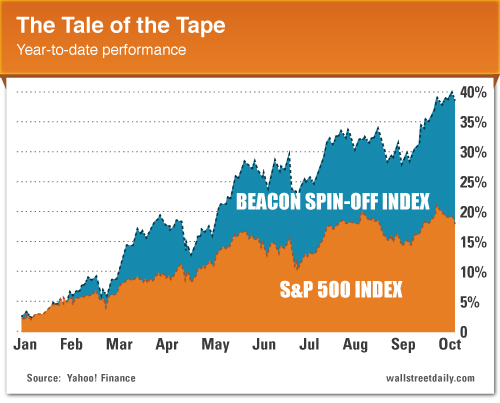Although politicians have gone from unofficially doing nothing to officially doing nothing, we’re still here plugging away. Same as it ever was.
Our mission? To help you avoid unnecessary risks and, most importantly, outperform the stock market.
Of course, with the S&P 500 up a stout 16.7% in 2013, that’s a tall order. But we’re more than up to the challenge.
In fact, I’m going to share a simple strategy that’s not only trouncing the S&P 500 this year (it’s up 38% – more than double the market’s return), it routinely crushes the market year in, year out. By an average of 13 full percentage points, according to Credit Suisse (CS).
Oh, and the best part? It couldn’t be easier (or cheaper) to implement.
No excessive research involved. No complex options strategies required. Just a simple click of your mouse.
And no, this isn’t a marketing piece. It’s a straight-up investment recommendation. So let’s get to it, shall we?
It’s Time to Enter the Spin Zone
In the entertainment world, spin-offs almost always flop (think Joey from Friends).
In the investment world, however, they almost always pop.
To be clear, I’m talking about when a large, publicly traded company decides to spin out a specific division to form a new, independent company. For example…
- When Altria (MO) spun off its international division, Philip Morris (PM), in 2008 through a share distribution.
- Or when EMC Corp. (EMC) spun out VMware (VMW) in 2007 via an IPO.
- Or, more recently, when travel website, Expedia (EXPE), spun off TripAdvisor (TRIP).
And almost without exception, spin-offs hand investors market-beating returns.
Case in point: Over the last 12 years, the average spin-off delivered a 70% return to shareholders, according to a Forbes analysis of more than 80 transactions. By comparison, the S&P 500 only returned 22%.
The trend has continued this year, too. While the S&P 500 is up almost 17% year-to-date, the Beacon Spin-Off Index is up nearly 40%.
So as long as large companies keep spinning off smaller ones, we’re all but guaranteed to beat the market by investing in them.
And they will, given their need to continually unlock hidden value, as well as the tax efficiency of a spin-off over an outright sale.
The question then becomes: What’s the best way to get a piece of the action?
How to Invest Spin-Offs That Pop, Not Flop
We could scour SEC filings and the internet for upcoming spin-off opportunities. And then purchase shares of the parent company in advance.
Put simply, if “iPhone, Inc.” ever spun off from Apple, it’d draw our investment attention, for sure.
A more relevant example would be what’s happening with Bob Evans Farms, Inc. (BOBE). Activist shareholders are calling for the company to spin off its packaged goods business.
But this kind of strategy is fraught with risk. For one, it pegs our investment fortunes on a single deal. It also involves owning the parent company, which we don’t always want to do.
Not to mention, it requires a considerable amount of time to sleuth out the most attractive opportunities.
Instead, it makes much more sense – and involves considerably less risk and time – to buy the Guggenheim Spin-Off ETF (CSD). Here’s why…
~ Diversity: Right off the bat, we get exposure to up to 40 of the market’s most compelling spin-off opportunities in a single purchase.
~ Protection: In addition, no single company accounts for more than 5% of the overall portfolio. That means in the rare event of a spin-off flop, it won’t even make a dent in the fund’s performance – and, in turn, our investment.
~ Maximum Opportunity, Minimum Effort: The fund is rebalanced every six months, too, giving us access to the freshest opportunities without lifting a finger.
~ Small-Cap Weighting: The fund tends to be dominated by small- and mid-cap companies. As I’ve shared before, that’s precisely where we want to invest right now.
~ Smart Weighting: The fund is currently overweighted to the consumer discretionary and industrials sectors. That’s a positive. The former is the S&P 500’s top-performing sector this year, up 27.7%. The latter is no laggard, either – up 21.9% year-to-date.
And according to Bank of America’s (BAC) Head of U.S. Equity and Quantitative Strategy, Savita Subramanian, industrials are poised to continue outperforming, too.
Her latest report outlines 10 reasons to be bullish on the industrial sector, including price momentum, improving global growth, compelling valuations and a tendency to outperform during rising interest rate environments.
In other words, the GuggenheimSpin-OffETF gives us exposure to three sweet spots for growth in the market.
But there’s more. And it’s not a second ShamWow at absolutely no extra cost!
It concerns how much money we’ll have to shell out in fees. The fund’s expense ratio checks in at an affordable 0.65%. For that price, there isn’t a single money manager on the planet who can consistently outperform the market like the Guggenheim Spin-Off ETF.
Bottom line: If you’re looking to consistently outperform the market, easily and affordably, it’s time to enter the spin zone. Add some shares of the Guggenheim Spin-Off ETF,or miss out.
Original post
